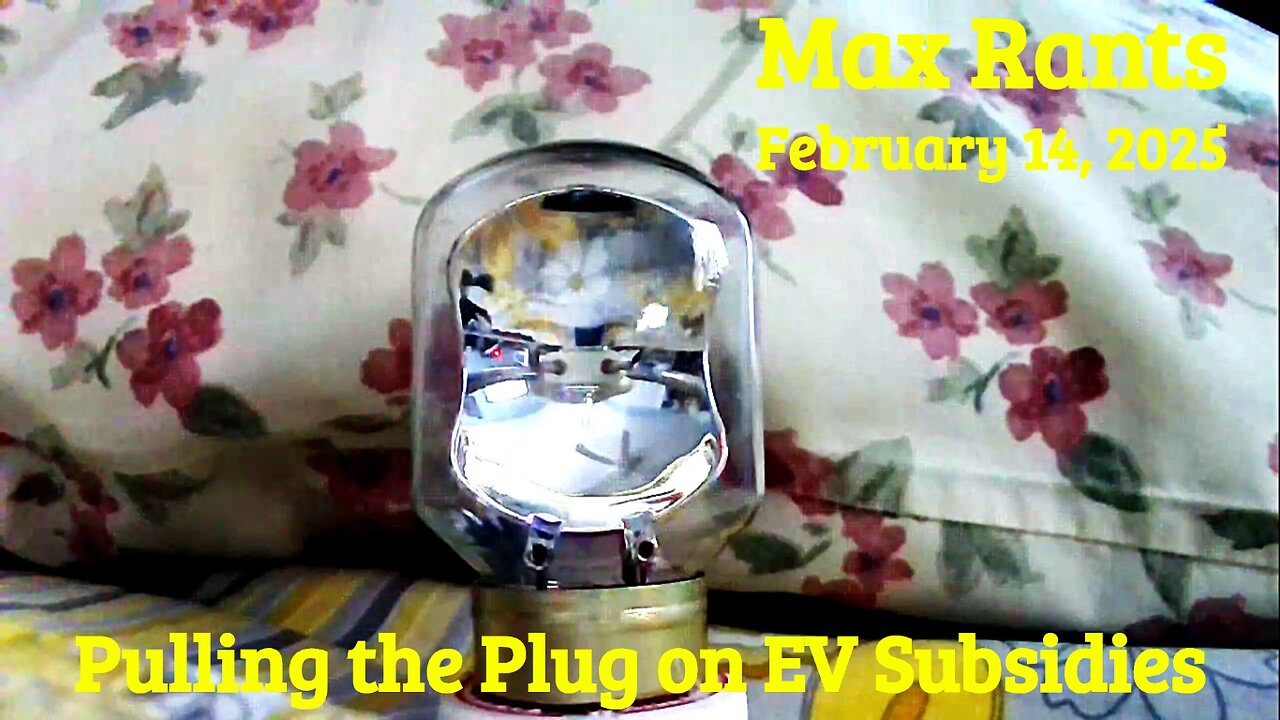Premium Only Content

WHAT HAPPENS TO EV SALES WHEN SUBSIDY ENDS?
THE GOVERNMENT PREPARES TO PULL THE PLUG
EV subsidies are slated to be discontinued as DOGE explores the waste.
Despite his own interest in Tesla, Elon Musk’s DOGE is digging in the dirt of government subsidies which are all ne to sustain EVs production. In fact, without billions of dollars in subsidies, the current figure would be less than 10%. This is because, with the exception of Tesla Motors, all EV makers lose money on every electric vehicle they sell.
Click here: https://nypost.com/2025/02/13/opinion/pull-the-plug-on-ev-subsidies-a-costly-government-racket/
EVs offer such a plethora of advanced features and technological innovations that people might think theirs is the sole province of the Electric Vehicle. That’s not true. Virtually all of these cool gadgets and features are available in new gasoline and diesel vehicles at much lower prices.
For most consumers, EVs are, at best, a lateral technology (that is, if you don’t drive in cold weather or over long distances). When you watch television, you won’t believe that EVs account for only 9% of auto sales. This is because TV advertising has increased by nearly 400% over just the past two years. By this, you’d think that Americans were standing in line to get one.
Despite this advertising binge, EV sales have increased by only a fraction of a percentage point since last year. This is despite the endless advertising, great press, and huge government subsidies. Even with over a decade of government help, EVs make up less than 9% of all new car sales. And most of these are sold to the wealthy (and government fleets). Electric vehicles have come to be status symbols for the upper class.
It’s no big surprise that Ford projected recently it would lose $5.5 billion on its EV sales this year alone. This means that if they stopped making EVs altogether, Ford’s profits could spike by as much as 50%. That’s a windfall if there was any. Last year, Ford lost another $5 billion, or around $60,000 on every one of the 20,962 EVs it sold. In 2023, Ford lost $4.7 billion on EVs. In 2022, Ford lost $2.2 billion on EVs. Can you tell me what’s going on? This is not a situation unique to the Ford Motor Company!
Electric vehicles release more toxic emissions, are worse for the environment than gas-powered cars: study
What kind of mentality continues to manufacture a product that loses more money per unit every year and undermines shareholder profits? That would be a way to ignores market signals so as to respond to draconian government threats and lucrative government incentives. Ford, of course, believes that when the EV bubble bursts [and it is about to] taxpayers will bail them out. Maybe.
Among all major auto makers, Ford, strong-armed by the Biden administration, promised that 40% to 50% of all new cars it sold by 2030 would be EVs.
Threat from Biden administration amounted to “do it or die” financial threat. If you or I put that kind of pressure on anyone else, we’d be sharing a cell with someone named “Vinny” or “Bubba.” It’s extortion.
Still enforcing Biden-installed standards, the Environmental Protection Agency’s greenhouse-gas-emissions standards demand that all carmakers make 32% of new sales EVs and hybrids by 2027. Furthermore, the threat is that, by 2023, no more than 29% of new sales can be gas-powered. Good luck with that! As of now, every major car company, other than Tesla, loses money on electric vehicles. Patents and unique processes, along with clever marketing strategy, have made Tesla profitable without the massive government incentives.
Biden is already gone, and Honda and General Motors, feeling the breath of relief, have canceled plans to make new EV models. It’s a fact that there’s no demand for these. Toyota has cut global EV production by a third. As we all know, this is the fact that EVs have enjoyed a $7,500 federal tax credit, up to $12,500 in some cases.
Only a few years back, a study by the Texas Public Policy Foundation found that without government credits and subsidies, the average cost of electric vehicles would increase by $48,698. That’s in addition to their prices which are already nearly unaffordable. Can you even imagine how few EVs would be sold if consumers had to pony up an additional $50,000 to buy one?
Even though the stocks of electric carmakers have significantly fallen from their historic highs, they are still propped up by the knowledge that the government considers them to be “too big to fail.” And it’s not just the cars themselves: There are so many government credits, grants and loans associated with the EV boondoggle, such as battery factories and charging stations, that it’s difficult to keep track.
We keep pumping up the bubble. More and more dollars go in to support that which is doomed to failure by simple cost analysis and science alone. But even with seemingly endless government subsidies and inducements, companies like Canoo (which lost $900 million and produced a grand total of 122 cars).
Things haven’t gone well for any EV maker with the rare exception of Tesla.
Fisker (which filed bankruptcy twice, failing to pay back a $139 million federal loan), Lordstown Motors (which went through hundreds of millions of dollars consisting of Ohio taxpayer money and federal funds, and manufactured 56 electric SUVs total). These are just a couple of examples. I am sure Elon Musk’s DOGE will find a lot more.
Before leaving office, Joe Biden handed a $6.6 billion low-interest “loan” to EV maker Rivian so that it could finish building its new factory in Georgia. It’s a joke to even call Rivian an EV maker since they are so far in the red that production will cease completely before the factory is completely open or operational. Projections show them failing by the end of March of this year. Without more “loans”, this money pit would collapse under its own weight.
Now, if people want to buy electric cars, they should of course be able to. I have a brother who swears by his, and a few friends who swear AT theirs.
On one hand, people love the quiet motor, the quick acceleration and the way they look. On the other hand, they dislike cold weather performance, long charging times, exorbitantly priced batteries, range anxiety, and a resale value that is lowest of all other automobiles.
Some people assume there would be a profitable niche market for EVs if the industry significantly scaled back production. Let’s find out, because taxpayers shouldn’t be subsidizing these ‘toys’ of the rich and government.
-
 16:38
16:38
T-SPLY
19 hours agoDemocrats Are At President Trump For "Liberation Day"
94.8K59 -
 1:02:20
1:02:20
TheDozenPodcast
21 hours agoAttempted TERROR attack & visiting Tommy Robinson: Chas Symonds
37.8K7 -
 11:27
11:27
IsaacButterfield
1 day ago $5.23 earnedEngland Is Dangerous
32.5K41 -
 37:33
37:33
The Rich Dad Channel
1 day ago5 Shocking Predictions for 2025 (Best of Rich Dad Radio with Robert Kiyosaki)
38.3K4 -
 10:04
10:04
NinjaGamblers
1 day ago $1.29 earnedHow The Romanovsky Roulette System Wins 86.48% of the Time!
33.9K7 -
 23:07
23:07
Uncommon Sense In Current Times
19 hours ago $1.75 earnedDefending Your Christianity Without Overcomplicating It (Part 2) | Greg Koukl
43.7K8 -
 5:08
5:08
Gun Owners Of America
19 hours agoDebunking Everytown's False Claims About Us
28.9K4 -
 1:00:59
1:00:59
Trumpet Daily
22 hours ago $6.17 earnedTrump Unites the World Against America - Trumpet Daily | Apr. 3, 2025
33.9K9 -
 4:13:56
4:13:56
Alex Zedra
13 hours agoLIVE! VERDANSK!!!!!
103K21 -
 LIVE
LIVE
SpartakusLIVE
23 hours ago24 HOUR STREAM w/ The MACHINE on Verdansk
257 watching